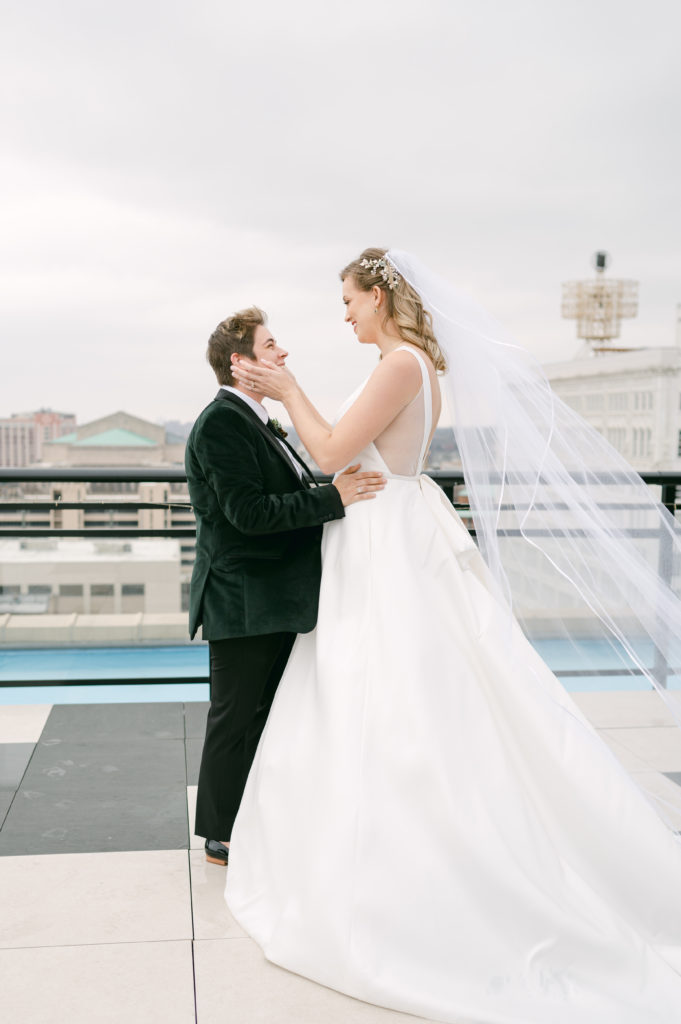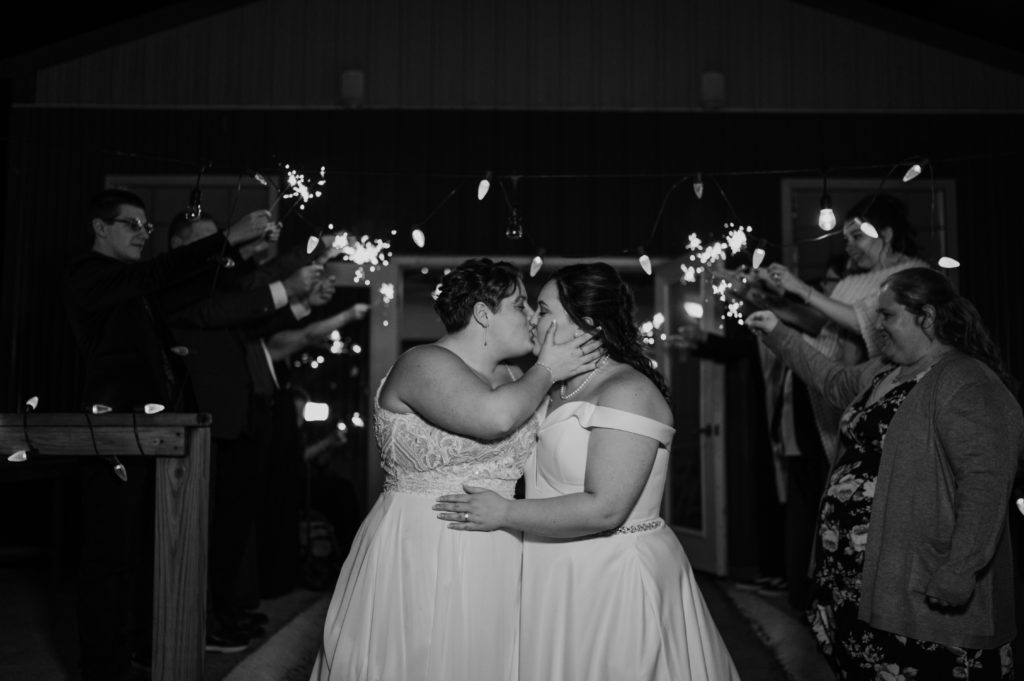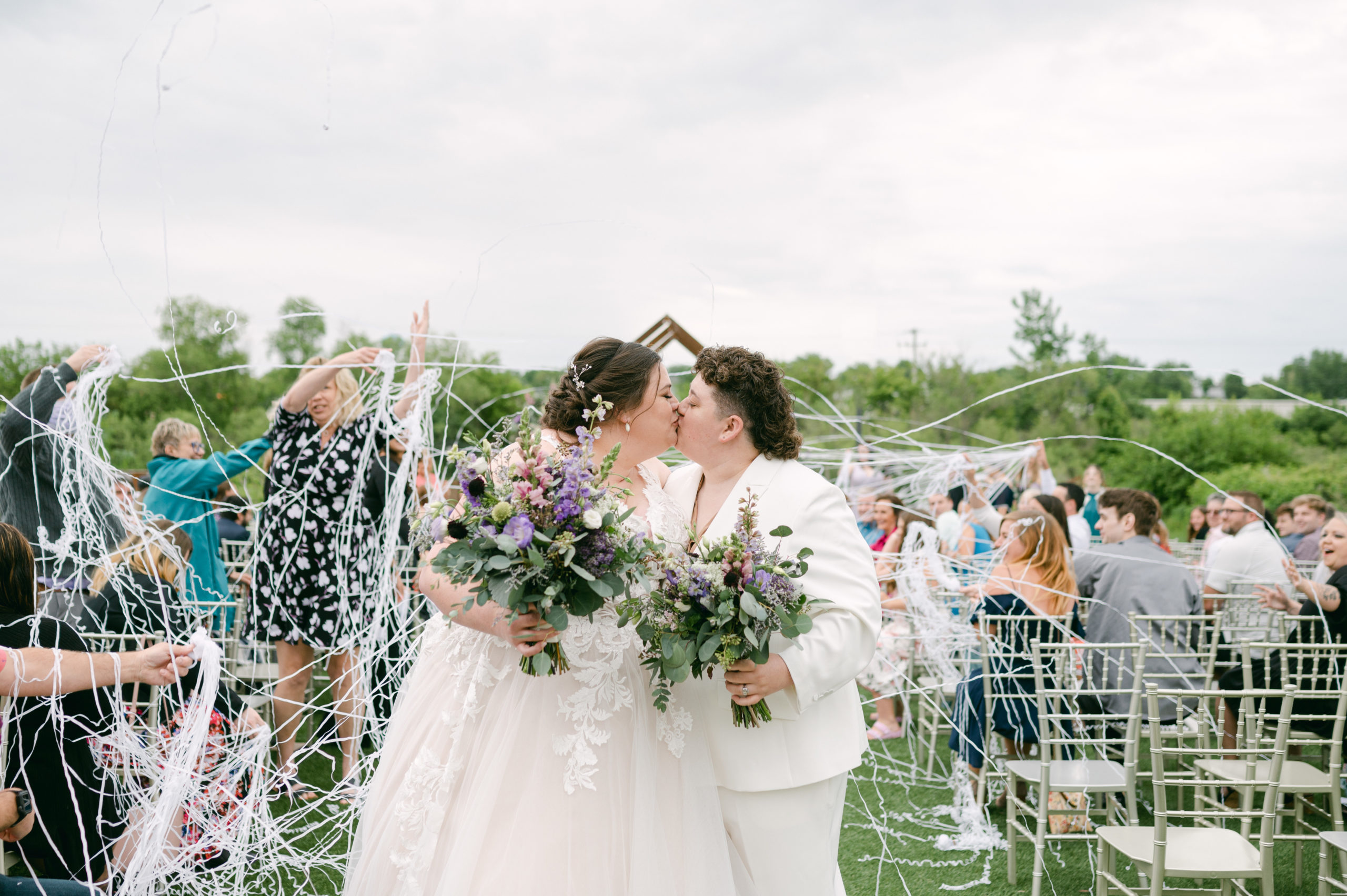September 12, 2022
Becoming an LGBTQ+ inclusive wedding vendor is essential to lovingly embrace the diversity of couples getting married in 2022, 2023, and beyond. However, being an inclusive vendor is so much more than putting ‘Love is Love’ in your Instagram bio. Whether you are a photographer, planner, florist, DJ, officiant, or another wedding professional, these tips will help you showcase that you serve all types of love, including LGBTQ+ couples.

1. Understand the Terms that Define the LGBTQ+ Community
So much of becoming an LGBTQ+ inclusive wedding vendor is about shifting language. To shift your language, you must first understand the clients you serve. It’s okay if you don’t know every specific, niche identity, but it is good to be familiar with some terms. I will keep this more basic for the sake of understanding.

LGBTQ+ terms to understand
Gay – A man who is exclusively attracted to other men. Gay is also still used as an umbrella term in some circumstances, such as “the gay community” or “a gay bar.” Some people who do not identify as male may also refer to themselves as gay.
Lesbian – A woman who is exclusively attracted to other women.
Bisexual – A person attracted to people whose genders are like their own and unlike their own.
Pansexual – A person who is attracted to someone regardless of gender. Some argue that bisexual people are pansexual, while others say there is a distinction.
Transgender – A person whose gender identity differs from the biological sex they were assigned at birth,
Cisgender – A person whose gender identity matches the sex they were assigned at birth.
Asexual – A person who experiences little to no sexual attraction. This identity exists on a spectrum.
Gender non-conforming; genderqueer – A person who expresses gender outside of traditional norms or beyond the binary understanding of gender.
Nonbinary – A person who identifies as neither male nor female and sees themselves outside the gender binary. Non-binary individuals often, but not always, use they/them pronouns.
Pronouns – The words used to refer to someone in place of their name. She/her, he/him, and they/them are the most common pronouns, though others exist and may be used. Please note that it is important to use pronouns, not preferred pronouns. They are not preferences, they are important identities.
Queer – An umbrella term referring to one or more sexual orientations other than heterosexual; often used as a synonym for LGBTQ+. The term can also be used to describe one’s sexual orientation or gender identity. Please note: Some people find the term offensive and it typically should not be used by those outside of the LGBTQ+ community without explicit permission from the individual.
Please also recognize that some LGBTQ+ people choose not to hold tightly to any specific identity, while others may have their own interpretations of these terms. Labels are only as useful as they are helpful to the individual. For more information, I encourage you to research these topics further (see #5 on how to continue your research).

2. Use Inclusive Language
The wedding industry standards of ‘bride and groom’ do not apply to every couple. The wedding industry has been built on terms that assumes the couple getting married has one bride and one groom. However, LGBTQ+ couples often have two brides, two grooms, two nonbinary individuals, or some combination of those individuals. LGBTQ+ people often feel uncomfortable being put into the particular ‘bride and groom’ box.
Keep in mind that you may not always know if one or both of the partners in a couple are LGBTQ+. One of them may be nonbinary, transgender, bisexual, pansexual, etc. Using these terms at all times (even if you think the couple you are speaking with is a straight, cisgender couple) ensures you’re creating a safe space for everyone.
Easy switches for gender-inclusive language
Some examples of easy switches include:
Bride and groom or husband and wife — couple, partners, marriers, newlyweds, spouse
Bridal (suite, party, dress) — wedding (suite, party, dress)
“For brides” — for future clients, for future couples
This list will get you started, but be mindful of when language is gender-specific and switch it to something more inclusive! It takes a little bit of work to make the mental switch from gender language to gender-inclusive language, but once you begin to do so, it will become easier over time.
Normalize sharing pronouns
State your pronouns upon meeting, in your email signature, and on your website. This normalizes sharing pronouns for all people so that transgender individuals do not feel called out or ostracized. Sharing your pronouns will let your clients know you’re a safe person to share their pronouns with, another important step in becoming an LGBTQ+ inclusive wedding vendor.
For example, when introducing yourself, you could say, “Hi! I’m Tawny. My pronouns are she/her.” Then, when your couple introduces themselves to you, they will be comfortable in sharing their pronouns, too.
More than same-sex couples
The LGBTQ+ community is so much bigger and more beautiful than just gay or lesbian couples. As you see with the terms above, those in the community are more than those in same-sex relationships. For example, your LGBTQ+ couple could be two opposite-sex bisexual identifying individuals. They could be a transgender man and a queer cisgender woman. The possibilities are endless. Therefore, avoid using “same-sex couple” as a replacement for or interchangeable with LGBTQ+.

3. Curate an LGBTQ+ Inclusive Portfolio
Show on your website and social media that you serve LGBTQ+ couples. This begins with showcasing them throughout your website and any social media platforms you utilize. Showcase diversity within your posts and on your portfolio pages. People want to see themselves represented when hiring a wedding vendor.
If you do not have LGBTQ+ couples in your portfolio, consider hosting or attending a styled shoot. Be sure that the couple you use for the styled shoot is a real LGBTQ+ couple! It is in poor taste to pose two straight individuals as an LGBTQ+ couple, especially when there are so many amazing LGBTQ+ couples who would love the opportunity.
Be honest about your intentions of hosting the styled shoot. Be sure your styled shoot only features LGBTQ+ inclusive wedding vendors, and if you can, include LGBTQ+ owned businesses and/or wedding vendors in the styled shoot.
It is important to not tokenize or stereotype LGBTQ+ people but to strive for genuine and authentic inclusion of all couples. Let LGBTQ+ couples be themselves during a styled shoot. Avoid assuming one is more masculine or feminine. Continually checking in with each partner to see what they are comfortable with when it comes to clothing choice, posing, and anything else that is typically gendered will help them be their most authentic selves. In turn, your couple will be comfortable and trust you to do what you do best.

4. Be an Ally: Support the Community as an LGBTQ+ Inclusive Wedding Vendor!
To serve the LGBTQ+ community, it is important to be an ally. Supporting the LGBTQ+ community should not come from a place of personal benefit, but a place of genuine care and a desire for inclusion.
One way to do this is to speak up about the issues that affect the LGBTQ+ community all year, not just during Pride Month. Anti-LGBTQ+, and especially, anti-trans, bills are continually introduced in an attempt to take away the rights of LGBTQ+ people. Educate yourself on these bills. The ACLU website is a great place to start and is updated weekly. Speak out against the hatred that the LGBTQ+ community faces. Call your representatives and demand equality. Donate to LGBTQ+ supporting organizations, both local and national.
It takes much more than turning your logo rainbow and being accepted to be a truly LGBTQ+ inclusive wedding vendor. Take action. Speak out when you hear or see homophobic, biphobic, and transphobic things. Support LGBTQ+-owned businesses all year around. Collaborate with LGBTQ+ wedding vendors.

There is so much more that could be said about becoming an LGBTQ+ inclusive wedding vendor, but understanding the terms that define the LGBTQ+ community, using inclusive language, curating an inclusive portfolio, and taking steps to ally-ship are all great places to start.
Continue your education on becoming an LGBTQ+ inclusive wedding vendor. There are many resources out there designed to help you. My Guide to LGBTQ+ Inclusion for Wedding Vendors includes setting your intentions to become an inclusive vendor, how to be an ally, language switches to make for your brand, Do’s and Don’ts of being inclusive, industry-specific tips for photographers, hair and makeup artists, planners, officiants, DJs, wedding attire providers, and venue owners + managers, a social media and website checklist and more.
EquallyWed also has a great course to become certified in LGBTQ+ inclusivity. The LGBTQ+ Inclusive Certification Course gives you the resources you need to be authentically inclusive.
To be an LGBTQ+ inclusive wedding vendor is to authentically embrace the LGBTQ+ community. It takes honest effort and work to be an ally, but your work helps all couples know they are accepted by you and your team and that you believe love is love. Thank you for taking steps to become an ally and make the wedding industry a more welcome place for all.

Want to see how I pose LGBTQ+ couples? Take a look at my portfolio.
